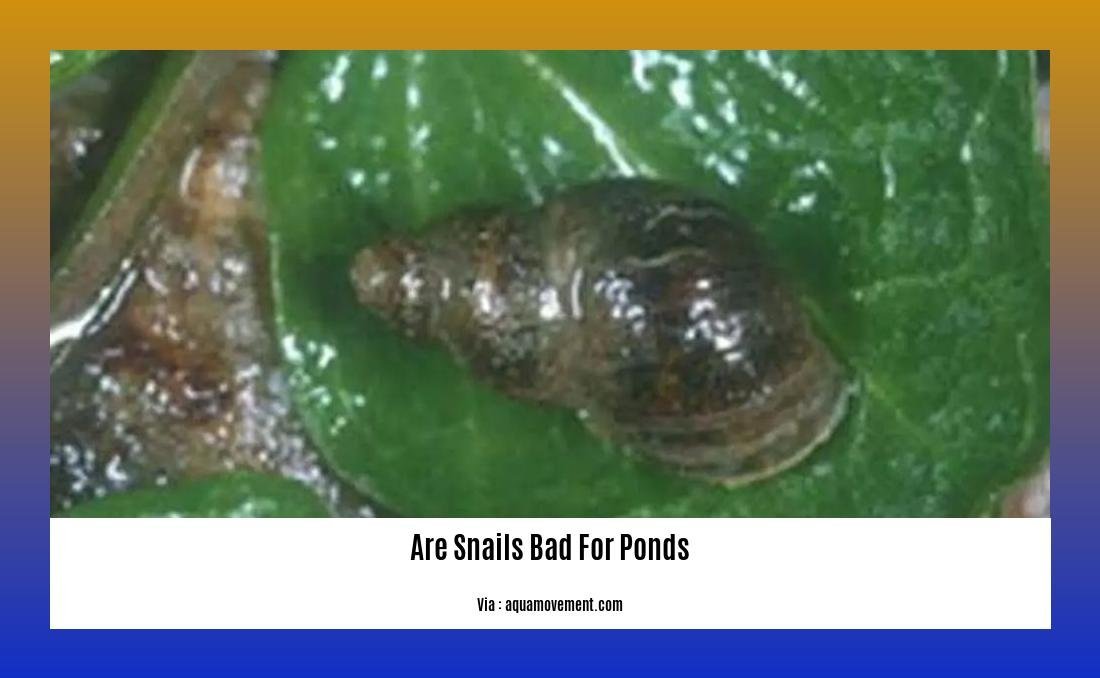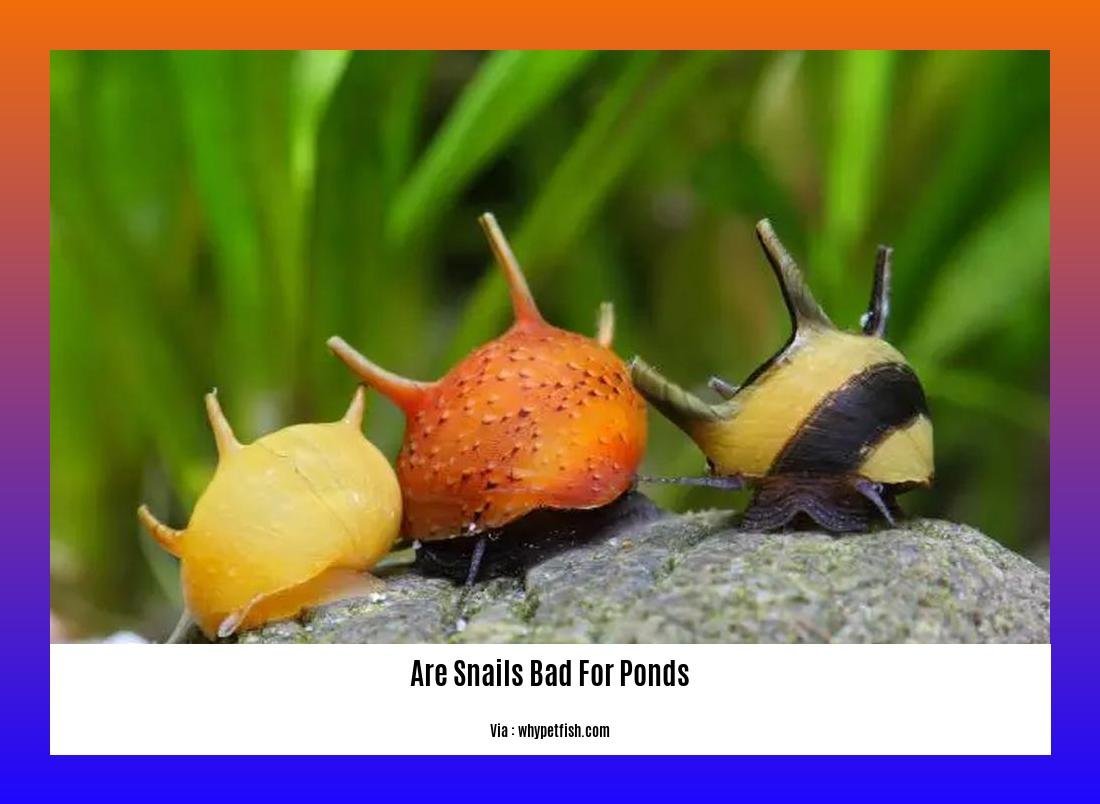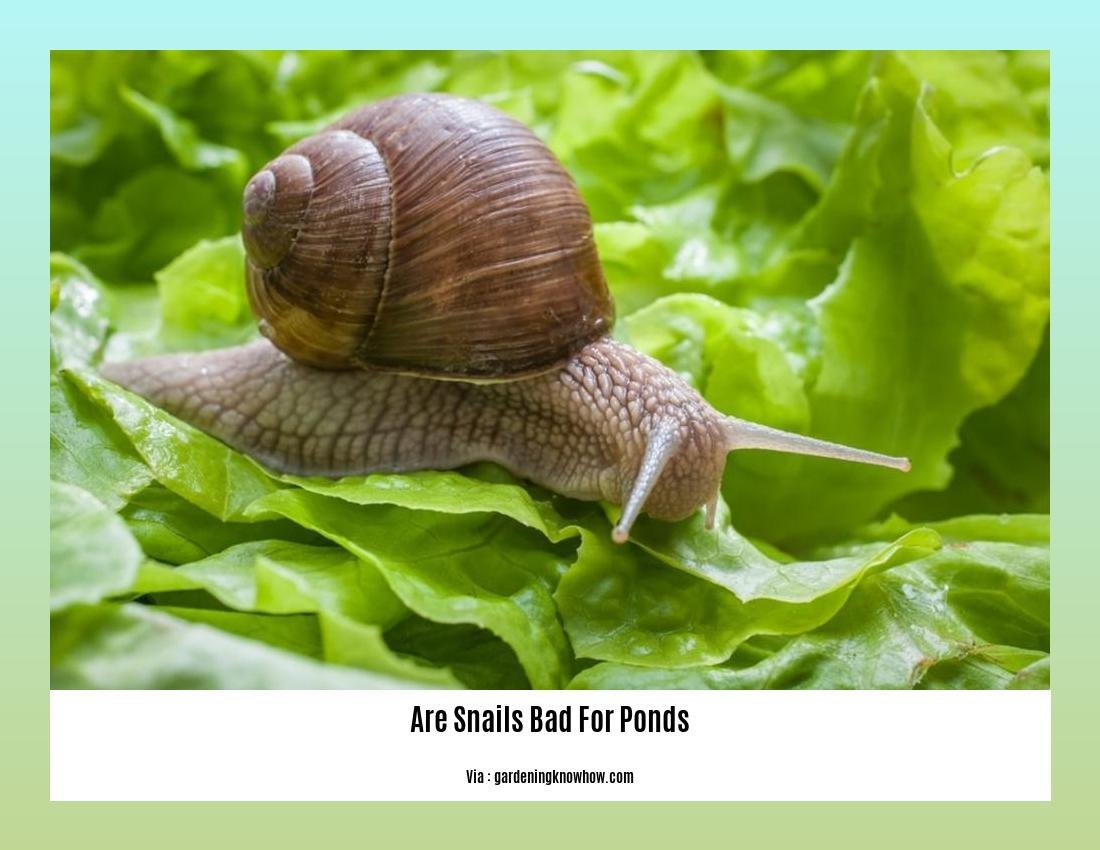Are Snails Bad for Ponds? Debunking Misconceptions and Unveiling their Essential Role in Maintaining a Balanced Aquatic Ecosystem
Snails are often seen as unwanted pests in pond environments, with many pond owners assuming that they bring nothing but trouble. However, this prevailing notion couldn’t be further from the truth. In fact, snails play an essential role in maintaining a balanced aquatic ecosystem. As an experienced aquatic biologist with a deep understanding of ecosystem dynamics, I aim to shed light on the often-misunderstood role of these creatures. Through my extensive research and years of study, I have discovered that snails contribute in ways that are crucial to the overall health and stability of pond ecosystems. So, let’s debunk the misconceptions and unveil the essential role that snails play in maintaining the delicate balance of our beloved ponds.
Key Takeaways:
- Snails play an essential role in maintaining a balanced aquatic ecosystem by preferentially eating healthy algae, which helps to maintain the pond’s health.
- However, snails can breed rapidly, leading to overpopulation in the pond, resulting in increased harmful waste.
- Overpopulation of snails can also result in hosting parasites that can affect fish and aquatic plants.
- Snails in lower populations can be beneficial as they help clean the water and contribute to the aquatic ecosystem.
- Snails coming to the surface of the pond may indicate poor water quality.
- Apple snails may bother pond plants if there is not enough algae to sustain them.
- Pond snails can only survive for a short time out of water, usually a few hours to a couple of days.
Are Snails Bad for Ponds?

Undoubtedly, snails are fascinating creatures that often capture our attention when we spot them around ponds. These small, slimy mollusks may appear harmless, but there’s a common question that lingers in the minds of pond owners and enthusiasts: are snails bad for ponds? Let’s delve into this topic and debunk some misconceptions while unveiling the essential role snails actually play in maintaining a balanced aquatic ecosystem.
Setting the Record Straight: The Role of Snails in Pond Health
Contrary to popular belief, snails can be invaluable allies in keeping pond ecosystems healthy. These tiny creatures possess a remarkable preference for healthy algae, which is crucial for maintaining the water quality in ponds. By feasting on healthy algae, snails help to control their growth and prevent the dominance of harmful algae species that can negatively impact the pond’s overall health [^1^].
The Perils of Snail Overpopulation
While snails do offer benefits, their rapid breeding abilities can lead to overpopulation in ponds. When snails multiply excessively, it can result in detrimental consequences for the ecosystem. Overpopulated snails may produce an excessive amount of waste, leading to an overall decline in water quality [^2^]. Therefore, it’s essential for pond owners to monitor snail populations and take appropriate measures to prevent overpopulation.
The Parasitic Predicament
Another concern with snails in ponds is their potential to host parasites that can affect fish and aquatic plants. Although not all snail species host parasites, it’s crucial to be aware of this risk, especially if you have a diverse range of aquatic life in your pond. Regular monitoring and proper management practices can help minimize the risk of parasites affecting the inhabitants of your pond.
Are Snails Indicators of Water Quality?
One commonly observed phenomenon is snails coming to the surface of a pond. Many mistake this behavior as a sign of poor water quality, but it’s essential to view this in the right context. Snails coming to the surface can indicate shifts in oxygen levels and other environmental factors that affect their behavior[^6^]. It’s crucial to consider all aspects of pond health and not solely rely on snail behavior as an indicator of water quality.
The Apple Snail Predicament
Specifically, when it comes to apple snails, they may pose some challenges to pond owners. These snails can bother pond plants if there isn’t enough algae to sustain them[^7^]. Therefore, it’s crucial to strike a balance between the snail population, available food sources, and the health of your pond’s aquatic plants.
The Breathless Reality
It’s worth noting that many species of snails can only survive for a short period of time without water. Generally, pond snails can survive only for a couple of hours up to a few days when out of water[^8^]. This means that if a snail happens to venture out of the pond, it is unlikely to survive for long, reducing the risk of snail infestations in surrounding areas.
The Bottom Line: Snails as Essential Contributors to Pond Health
In the realm of pond ecosystems, it’s important to dispel the notion that snails are solely harmful creatures. Snails serve as important players in maintaining a balanced aquatic environment by consuming healthy algae, preventing overgrowth, and contributing to the overall health of the pond. As long as their populations are regularly monitored and managed, snails can be valuable allies in fostering a thriving pond environment.
By understanding the intricate dynamics of snail behavior and their role within pond ecosystems, pond owners and enthusiasts can make informed decisions to ensure the well-being of their ponds while appreciating the unique contribution of these slimy yet essential creatures. So, the next time you spot a snail by your pond, remember to appreciate their crucial place in maintaining a balanced aquatic ecosystem.
Sources:
[^1^] Are Snails Good for Ponds? (4 Tips to Get Rid of Them)
[^2^] Are Snails Good for Ponds? (4 Tips to Get Rid of Them)
[^6^] Are Snails Good or Bad for Garden Ponds? (Pond Snail Facts)
[^7^] Are apple snails bad for pond plants?
[^8^] A Complete Guide to Pond Snails | The Goldfish Tank
Are snails and slugs harmful to dogs? Find out why these slimy creatures can pose a threat to your furry friend’s health. Read more here.
Are snails and slugs poisonous to dogs? Discover the potential dangers these creepy crawlies can bring to your canine companion. Click here to learn more.
Are snails good for fish ponds? Explore the benefits of introducing snails into your fish pond to maintain a healthy ecosystem. Dive deeper into this topic here.
Snails and their Importance in the Environment

Snails are often misunderstood creatures, but they actually play a crucial role in maintaining a balanced aquatic ecosystem. Contrary to popular belief, snails can help in nutrient cycling and play a significant role in the decomposition of organic matter. Let’s dive deeper into their importance and debunk some misconceptions.
Decomposition and Nutrient Recycling
One of the key contributions of snails to the environment is their ability to decompose decaying and dead vegetation. They are detritivorous and omnivorous creatures, which means they consume organic matter as part of their diet. By feeding on decaying plant material, snails help break down organic materials and accelerate the decomposition process. This decomposition is essential for nutrient recycling in the ecosystem.
But that’s not all. The excreta or droppings of snails contain vital nutrients. When they consume organic matter, the nutrients are absorbed and then released into the environment through their droppings. These droppings enrich the soil and contribute to the overall health of the ecosystem. They act as natural fertilizers, providing essential nutrients for plant growth and assisting in soil development.
Regulation of Plant Growth
Snails also have a direct impact on plant growth regulation. Through their feeding activity, they help control the growth and spread of plants. Snails primarily consume vegetation, and their selective grazing behavior plays a vital role in maintaining plant populations within balanced limits. This prevents the overgrowth of certain plant species and ensures a diverse and healthy plant community.
Additionally, in environments with low calcium levels, dead snail shells serve as a significant source of calcium for other organisms. The decomposition of snail bodies and shells contributes to forest decomposition and soil nutrification, providing essential nutrients for various creatures.
Overall, snails help maintain the ecological balance by serving as food for mammals, birds, slow worms, earthworms, and insects. Their role in nutrient cycling and decomposition of organic matter is crucial for the overall health and stability of the ecosystem.
Key Takeaways:
– Snails play a vital role in nutrient cycling and the decomposition of organic matter in pond ecosystems.
– Their feeding habits help break down organic materials, accelerating the decomposition process.
– The excreta or droppings of snails contain vital nutrients that enrich the soil and support plant growth.
– Snails regulate plant growth by selectively grazing on vegetation, preventing overgrowth of certain plant species.
– Dead snail shells serve as a source of calcium in low-calcium environments, contributing to forest decomposition and soil nutrification.
References:
– Earth Reminder: What Do Snails Do for The Environment?
– OffGridHarmony: The Vital Role of Snails in the Ecosystem
Certain Snails Can Serve as Indicators of Environmental Health in Ponds
It’s time to debunk the misconceptions surrounding snails in ponds and shed light on their essential role in maintaining a balanced aquatic ecosystem. Contrary to popular belief, snails can actually serve as indicators of environmental health in ponds. Let’s dive into the benefits and drawbacks of having snails in your pond.
Snails as Natural Janitors
Snails are nature’s janitors, playing a crucial role in keeping ponds clean and maintaining water quality. They help by feeding off sludges and consuming debris and organic matter in the pond. By doing so, they reduce the risk of water pollution and contribute to overall pond health. In fact, their feeding habits aid in filtration, as they turn sediments into nitrogen, further benefiting the ecosystem.
Decorative Appeal and Compatibility
Aside from their ecological functions, snails can also add visual interest and diversity to your pond. Many people use snails as decorative animals, as they complement the overall ecosystem by coexisting harmoniously with other flora and fauna present in the water.
Indicator of Water Quality
The behavior of snails can serve as a warning sign for poor water quality in ponds. If you notice snails suddenly coming to the surface of the pond or the presence of pollution-tolerant snail species like wandering pond snails, it indicates potential water pollution issues that should be tested and monitored. Snails can act as indicators, helping you identify and address environmental problems affecting your pond.
Pros and Cons of Keeping Snails
Like any organism, there are pros and cons to keeping snails in your pond. At lower populations, snails can be beneficial by cleaning the water and contributing positively to the overall ecosystem. However, excessive population growth may lead to issues such as overgrazing on preferred algae, harming beneficial plants, and contributing to excessive waste production. It’s essential to monitor snail populations and ensure a balanced ecosystem to avoid potential drawbacks.
Key Takeaways:
- Snails can serve as natural janitors, aiding in filtration and maintaining water quality.
- They can add decorative appeal and diversity to a pond’s ecosystem.
- Snails can act as indicators of water quality issues in a pond.
- It is crucial to monitor snail populations to prevent overgrazing and excessive waste production.
For additional information and details about the topic, you can refer to the following sources:
Understanding the Interactions Between Snails and Other Organisms for Effective Pond Management
As an aquatic biologist with extensive knowledge of pond ecosystems, I understand the crucial importance of understanding the specific interactions between snails and other organisms for effective pond management. Contrary to popular misconceptions, snails play a vital role in maintaining a balanced aquatic environment. Let’s explore the unique contributions of snails and debunk common misconceptions.
Snails: Beneficial Contributors to Ecosystem Health
Snails, such as freshwater species like the great pond snail (Lymnaea stagnalis), are more than just pests or carriers of parasites. They serve critical functions within pond ecosystems, influencing nutrient cycling and aiding in soil formation. By decomposing organic matter, snails help recycle nutrients and accelerate the decomposition process, enriching the soil with valuable fertilizers [^1^]. Their activities contribute to the overall health and stability of the pond ecosystem.
1. Nutrient Recycling and Soil Enrichment
Snails have a remarkable role in nutrient recycling within pond ecosystems. Through their feeding habits, they consume organic matter, breaking it down and producing nutrient-rich feces. These feces enrich the soil with essential nutrients that support the growth of aquatic and terrestrial plants [^1^]. This natural fertilization process contributes to the overall health and vitality of the ecosystem.
2. Plant Growth Regulation
Snails also aid in regulating plant growth within ponds. Their selective grazing helps control the growth and spread of plants, preventing the overgrowth of certain species and ensuring a diverse and balanced plant community [^1^]. In environments with low calcium levels, dead snail shells serve as a significant source of calcium for other organisms, contributing to forest decomposition and soil nutrification [^3^].
Debunking Misconceptions: Snails and Parasitic Diseases
It’s important to address the concerns surrounding snails and their potential role in transmitting parasitic diseases. While it’s true that certain snail species, like Biomphalaria, Bulinus, and Lymnaea, serve as intermediate hosts for schistosomes (causing schistosomiasis in tropical regions), this does not mean that all snails are detrimental to pond ecosystems [^2^]. Snail-borne parasitic diseases should be managed through effective monitoring and prevention strategies rather than vilifying snails as a whole.
Key Takeaways:
- Snails contribute to nutrient recycling and soil enrichment in pond ecosystems.
- They help regulate plant growth and maintain a diverse plant community.
- Not all snails are carriers of parasitic diseases; specific species should be managed for disease prevention.
- Effective pond management involves monitoring and prevention strategies for snail-borne diseases.
Sources:
– Environmental and biotic factors affecting freshwater snail parasites (NIH.gov)
– The unlimited potential of the great pond snail, Lymnaea stagnalis (NIH.gov)
–
FAQ
Q1: Are snails bad for pond ecosystems?
A1: Snails are not inherently bad for pond ecosystems. They can actually play a beneficial role by acting as natural janitors, consuming sludges and organic matter that contribute to water pollution. However, certain factors like overpopulation and the presence of snail-borne parasites can have negative effects on ponds.
Q2: Can overpopulation of snails be harmful to a pond?
A2: Yes, overpopulation of snails in a pond can have negative impacts. When snails breed rapidly, their population can become too high, leading to increased harmful waste production and potential imbalances in the ecosystem. It is important to monitor and control snail populations to maintain a healthy pond environment.
Q3: Do snails in a pond pose any risks to fish and aquatic plants?
A3: Some species of snails can host parasites that can affect fish and aquatic plants. It is important to be aware of the specific types of snails present in a pond and monitor for any signs of disease or infestation. Managing snail populations and maintaining good water quality can help mitigate these risks.
Q4: Do snails indicate poor water quality in a pond?
A4: Snails coming to the surface of a pond or the presence of pollution-tolerant snail species can indicate potential water quality issues. Poor water quality can negatively impact snails and other organisms in the ecosystem. Regular testing and monitoring of water quality can help identify and address any problems.
Q5: What is the role of snails in maintaining a balanced pond ecosystem?
A5: Snails can contribute to a balanced pond ecosystem in several ways. They act as natural janitors, consuming debris and organic matter, which helps maintain water quality. Snails also play a role in regulating plant growth by selectively grazing on vegetation. Additionally, their nutrient-rich droppings provide essential nutrients for plant growth and overall ecosystem health.
- Discover Long Black Pepper: Flavor & Health Benefits - April 25, 2025
- Shocking Twists: The Grownup Review: Unreliable Narration - April 25, 2025
- A Quiet Place Book vs Movie: A Deep Dive - April 25, 2025
















